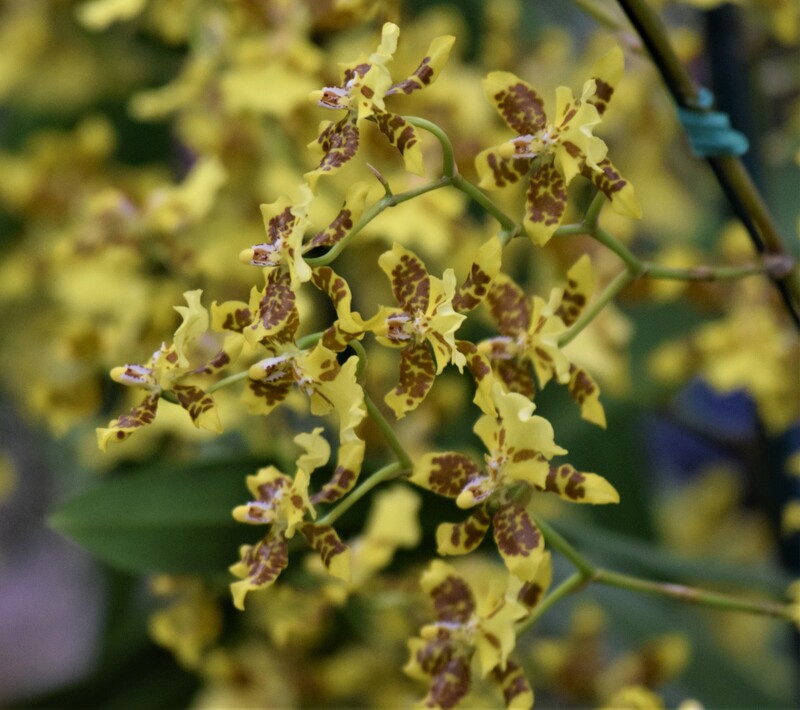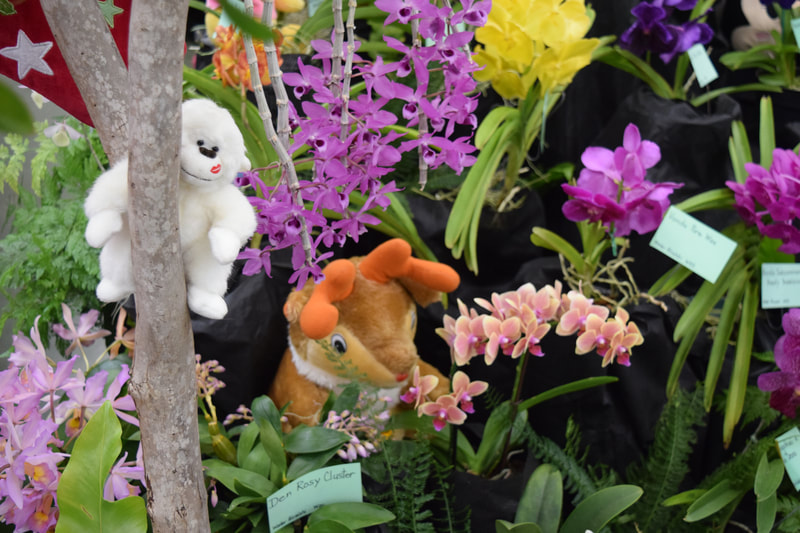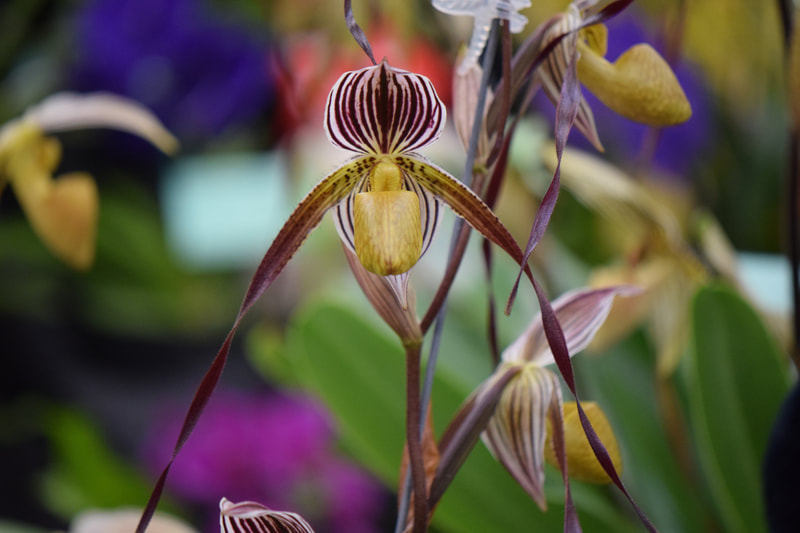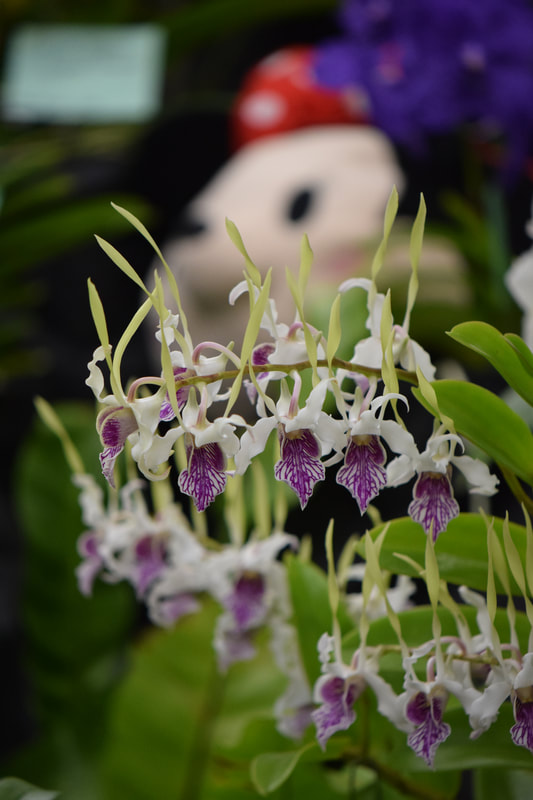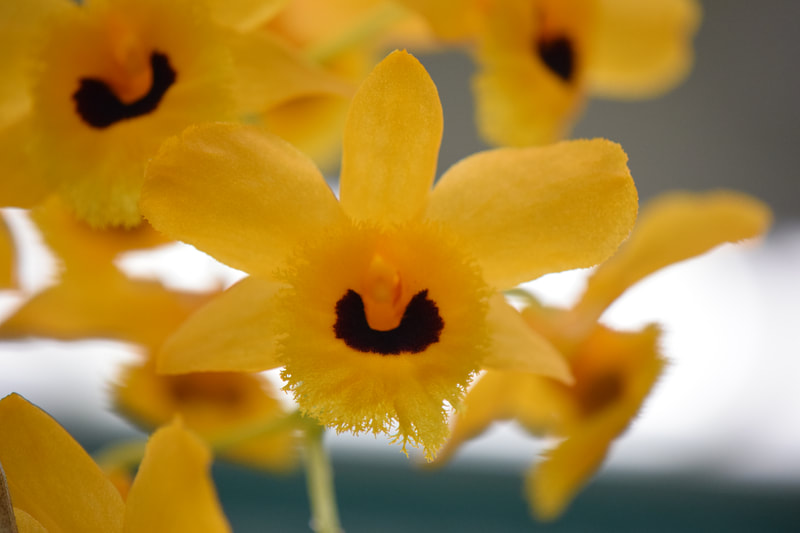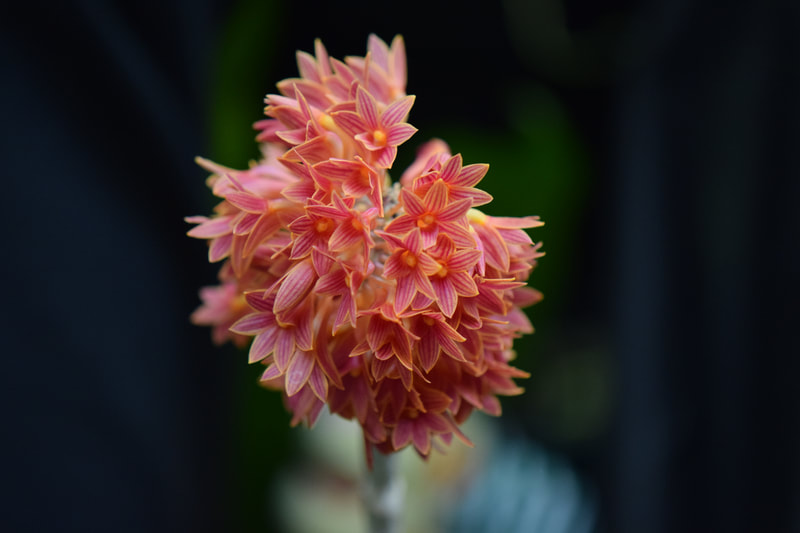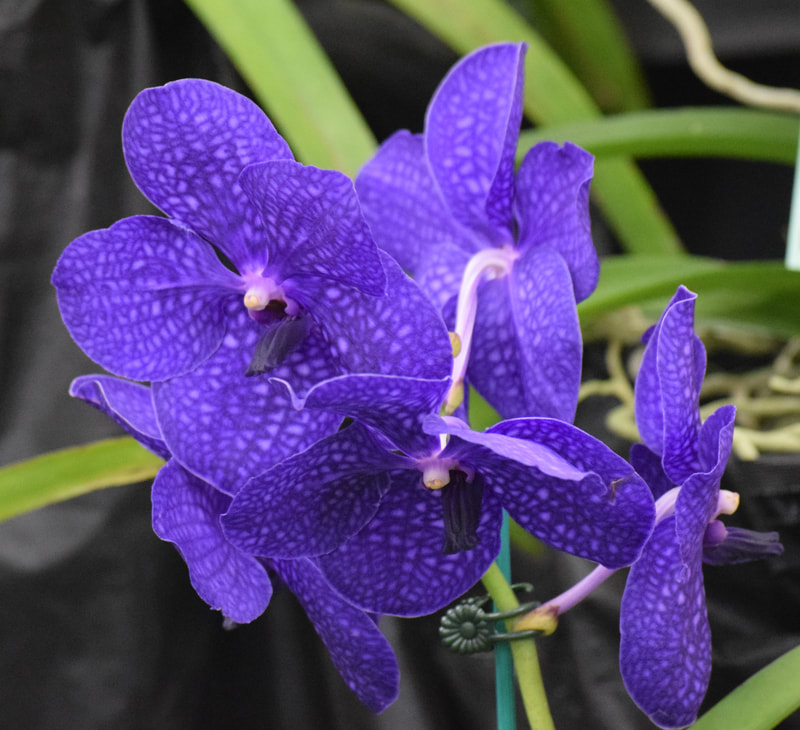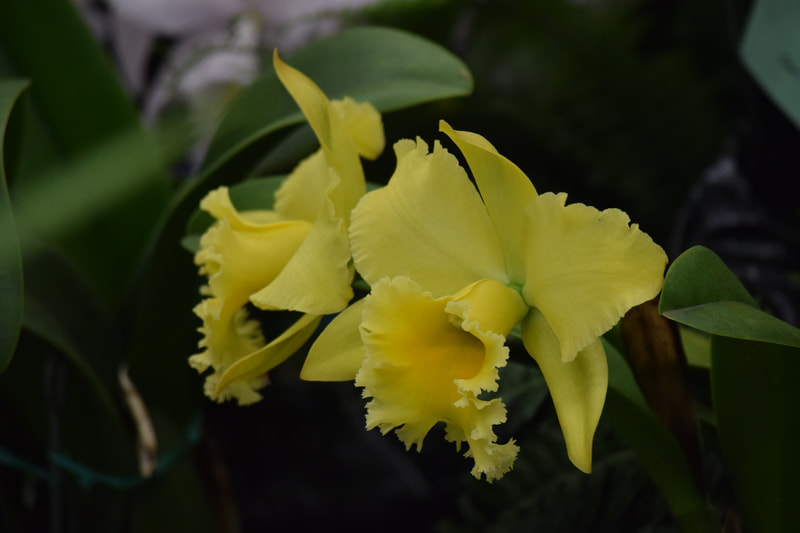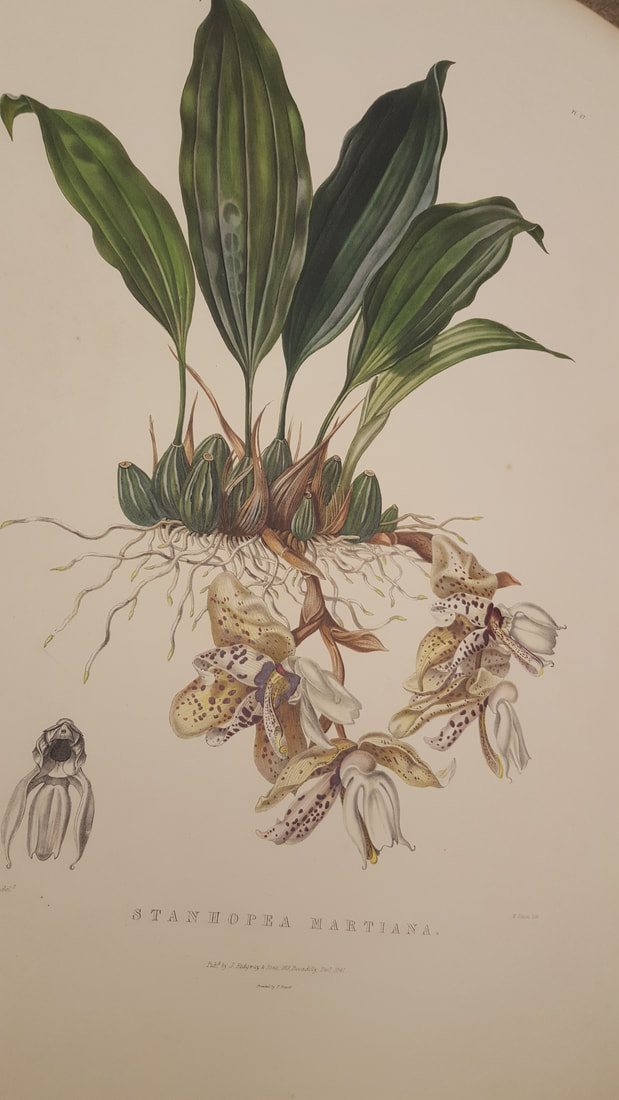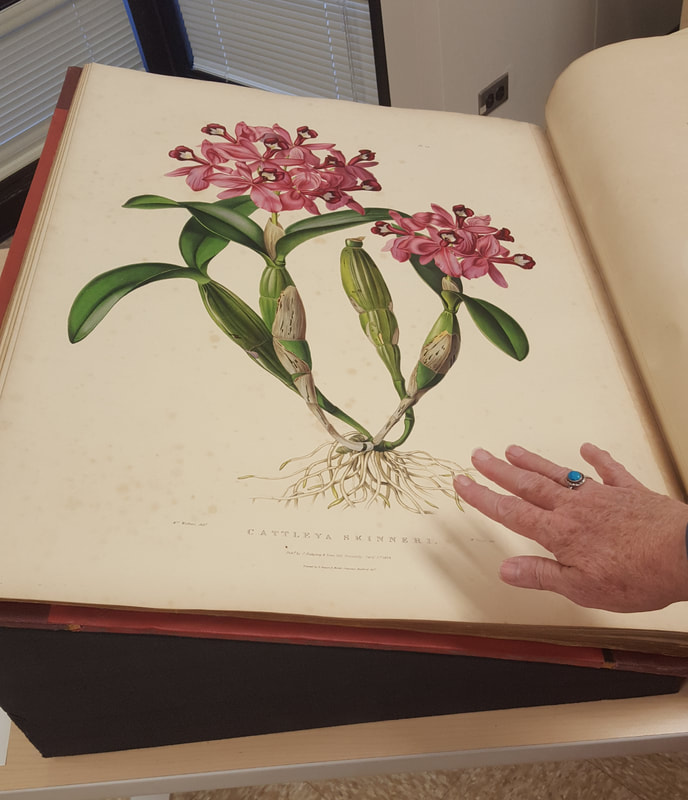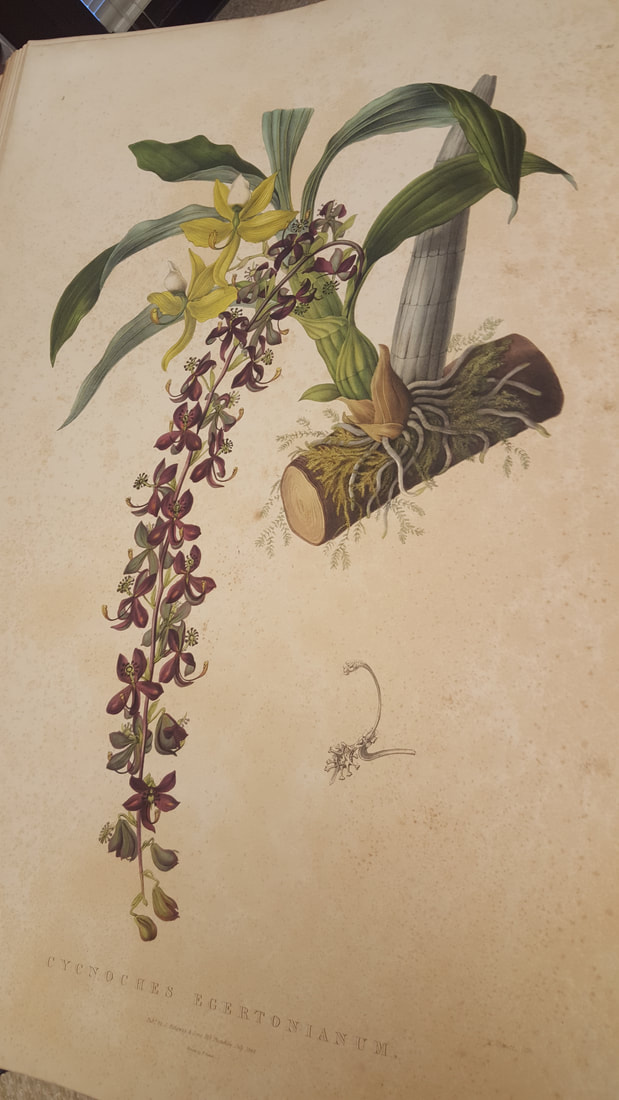|
March is usually our Spring Show season, and many of our normal show orchids will be coming into bloom. Unfortunately, for the second year in a row, we will not have our annual Spring Show. I am hopeful that this will be our last canceled show, as I feel that by next year, we will certainly have control over this virus.
Since the pandemic started, I have adopted a habit of preparing my orchids like a show is coming up. That means making an effort to stake and groom my orchids prior to blooming. Spraying my spikes/ buds to prevent flower thrip damage. Inspecting them for insects, slugs/snails, mites, scales and weeds. Staking them so that the flowers display well and the plants don't topple over. Removing old leaf and flower sheaths, dead leaves and other debris, and trimming dying or damaged leaves. Then, bring these beautiful orchids indoors to display and enjoy. If we can adopt this behavior throughout the year, we can stay on top of our orchid maintenance, instead of reacting to problem situations that occur because of a lack of attention. What a difference this is making in the general health of my orchids! Not only have I gotten a record number of flowers, but the size and quality of the flowers have greatly improved. I feel that by simply putting in this extra time and effort, has made me a better orchid grower, plus it's been great therapy! Instead of our Spring Show, the WOS board has planned another food drive that will be held on March 20th. Please visit us and bring food donations for this worthy event. We will be giving out boxes of orchids again, even blooming ones! I will be there too and I would be happy to answer any orchid related questions you may have. So please stop by, it would be nice to see everyone. Aloha, Scot Here are some Hawaiian winter reminders: Hopefully, we have been drying out our Hono Hono Dendrobiums. We normally start to dry them in December and keep them dry until February. Of course, this means no fertilizing too. In February, we will start to see the early blooming Honos start to initiate their buds from their leafless canes. Once you are certain that they are buds and not keikis, you may begin watering and fertilizing again. Later bloomers will take a little longer to initiate, so be patient. If you still have leaves on, it might not be too late to begin drying the plants. They can still bloom this year, but maybe a little later. All of this rain during their dormancy will affect the flowering. Some people opt to keep them under the eaves of their houses to keep the rain off them.
Our Phalaenopsis should be spiking and starting to bloom. Don't forget to begin staking the spikes upright when the first or largest bud is the size of a pea. This tells you that the lower part of the spike is hardened and no longer elongating. If you raise the spike now, you will have a beautiful upright cascading spike as the flowers open. Just note that some of the newer Phalaenopsis are bred to have shorter upright spikes that do not cascade well. So, don't be alarmed if it does not cascade naturally. You can always insert a #16 galvanized wire (the green florist wire will also work) into the bamboo and bend the wire and spike, so that the flowers will cascade the way that you want. Paphiopedilums, especially the complex and Maudiae types are also blooming. To avoid getting water into the pouches (which will shorten the life of the flowers), allow them to open at an angle, them stake them upright before you bring them indoors to enjoy. They will last a long time indoors and are tolerant to low light conditions. Dendrobiums are slow at this time of year, except for the Laturea types which are coming into flower now. For both types, try to keep them on the dryer side if possible. The indication that they are getting too much water, is that they will begin to drop some of their older leaves. If they get too wet, they are known to drop all their leaves. But don't worry, if you dry them out they should recover. Rhynchostylis are all beginning to bloom. We had given a few out over the years. They now come in all different colors and have a wonderful fragrance. If you don't have much flowering, they may be a good choice to get, as they are really dependable bloomers in January and February. Cattleyas are at their slowest right now. The whites, semi-albas, and light lavenders are finishing, and it is still a little early for the spring Guaranthes (Central American, small cluster types, i.e., aruantiaca, skinneri, and their numerous hybrids). Next month they should make their appearance and are a joy to see. Bright spring colors of yellow, orange, to red, small perky clusters of flowers will begin to bloom. Bulbul birds are normally at their worst during the winter months. There are not many fruits to feed on, so they are very hungry and often mistakenly bite the Dendrobium, Phalaenopsis, and Cattleya buds. I use a fake owl on a stick. It works if I move it daily. I also spray insecticide with some fungicide on the buds, they seem to dislike the taste. Another method is diversion. If they feed on alternate fruits, they may not feed on the orchids. Keep vigilant on the slugs and snails. Hopefully, they have been under control, but when it is always moist, they will continuously feed and yes, make more babies. So keep applying the baits, don't slack off! Watch for black/brown fungal/bacterial infections. Make sure that you cut off the diseased areas ASAP, treat with a fungicide, give it good air circulation and try to keep it dry. I go out daily to look for problems so that they can be treated right away. This allows me to keep the orchid alive. If unattended, the orchid will probably die and it will infect its neighboring orchids. Even if there are not a lot of flowers, there is still a lot of time that needs to be put into your orchid collection, I’m especially thankful that I can't catch COVID-19 from my plants!. Aloha, Scot Here we are in the New Year and my what changes have we seen. Who would have thought that we would experience such changes to our lives.
For most of us, our orchids are one of the few things that have benefited from the extra time and care they have received from their home bound owners. I am seeing a huge resurgence in growing orchids, house plants, and vegetable gardening. This brings some unexpected challenges. Getting orchid supplies! There is a terrible shortage of orchid bark, sphagnum moss, pots, bamboo stakes, and other orchid related supplies. Some of it is due to a slowdown of harvesting, but much of it is just that the demand is so high. Folks are staying home and working on their plants. Spring is the time when supplies normally become plentiful and garden shops run their advertisements. Hopefully we have enough to hold us until then. My advise this year is to acquire enough materials, plus some extra. The commercial nurseries have really put a dent in supplies this past summer and fall, and I don't think supplies will improve much. Can you imagine, people are actually hoarding orchid supplies! If you are able to get supplies make sure you store all organic materials in cool dry areas. This will keep them fresh longer and hopefully mold and fungus free. With all this extra time spent on our orchids, many of us are seeing our orchids blooming better than ever. Hopefully, one day we will have a show again, so we can share their beauty with others. Aloha, Scot December 21 officially brings us into winter. It is actually the shortest day of the year, so each day after gets longer. The reason I am exited about this is that for some of us, our orchids are not doing too much and the onset of longer days will encourage more growth from our orchids. But still, this is a good blooming season for Phalaenopsis, complex Paphiopedilums, Cattleyas, Angreacums, and others. Hopefully, our orchids have stored enough energy over the long summer months to give us a flowering holiday spectacular! This Covid 19 year has given me record blooms thus far and I hope to continue my good cultural roll into next year.
Finally it's been a little cooler and combined with the shorter days, I notice that I can really cut back on my watering. In fact, during this last rainy bout, things got over watered and I started to get some Black Rot or Phytophthora. This is the blackening of leaves and stems. It is a fungus that is easily spread by splashing water. As soon as you see the infection starting, get out your torch and pruners and start cutting back the infected tissue. Apply fungicide to the infected orchid and surrounding areas and try to keep them dry and aerated. This nasty fungus gets into the orchids vascular system and can spread rapidly if not controlled. As fungal infections appear, insect problems tend to lessen, but mollusk (slugs and snail) problems become rampant. We are seeing all kinds of mollusk damage on our Orchid ER website page, so I know what you guys are facing. Your control should be preventative instead of curative, because once the damage is done to the orchid, it may take years for it to recover. So apply your slug/snail bait and make sure you reapply within two weeks to get the new emerging young. In time, you will notice that different pests will attack our orchids at different times of the year, remembering this will allow you to take preventative actions, saving the damage to your valuable collection. My goal, is that soon you will be able to self diagnose your problems and you will no longer need my guidance. Only then will I know that I have succeeded in making you master orchidists! Aloha, Scot As we move towards the end of the year, we notice the days becoming shorter. As we mentioned last month, this signals the end of the growing season and the start of the blooming season for many orchids.
Phalaenopsis and single flowering Paphiopedilums will be initiating flower spikes. Make sure that while they are spiking you do not change their alignment to the sun, or the spikes will twist. Also remember that the sun is dropping towards our horizon in the southerly direction. In other words, southern exposures will be subjected to higher light intensities. This could cause sunburn on leaves. Also note that the temperatures are finally starting to cool down. Combined with increasing rainfall, watering will need to be cut back. During these times try to let your orchids dry slightly between waterings. This will help to deter fungal infections. Making these changes in your orchid culture will keep them healthy going into our winter season. Aloha, Scot October brings us into fall and hopefully to the end of our dry hot summer. It has been great for the growth of our orchids, but also great for the insect pests.
It is common that flower thrips and spider mites become major problems when it is dry. To avoid this, keep your orchids well hydrated. Don't be afraid to water the orchids from all angles, wetting the top and under the leaves. This is where the thrips and mites feed. Water will greatly disrupt their ability to feed. Of course, keeping your growing areas tidy by picking up dead or dying leaves and flowers, will prevent future outbreaks. If you are unable to gain control, you might need to treat your areas with Bayer 3 n 1. As things begin to cool down, the pressure from insects will lessen. Now begins the pay off time, when the orchids start to use all of their stored energy from summer to give us that fall show of flowers. Currently, it is prime time with lots of orchids in bloom. Especially Cattleyas, Dendrobiums, and Vandas. Just in time for the canceled Honolulu Show. But that's alright, I'm having a personal show all for myself! I'm just pleased to see the additional effort put into my orchids are beginning to show. I know you all are seeing great results too! Aloha, Scot September puts us in the second half of our hurricane season. So far this season we have been lucky again. As I am writing this, the tropics are exploding with potential storms, in fact the mainland U.S. may possibly be hit with two hurricanes at the same time! I am always concerned about the weather and want to be ready for any potential storm situation. I do not like to rely on the local news weather reporters. You notice that they often have different forecasts. The best information is found online at the NOAA website. Look for Hawaii Satellite Products. Here you will find the most reliable weather reports; they are surprisingly accurate.
This obsession with weather is because my Waianae farm was ravaged by Hurricane Iniki: metal street lamp greenhouse posts were bent, shade cloth was torn, and the orchids went airborne. Imagine orchids and their labels strewn about everywhere and the pots all at the end of the greenhouse. From this I learned an important lesson: affix your orchid label to your orchids, especially your good ones. I now use a hole punch and tie wire, and affix the label to the stake which I tie my orchids to--this way the label stays with the orchid at all times. This also prevents grandchildren from "helping" with your orchids by pulling out the labels. Other storm preparations include securing loose items in your yard, especially the orchids. No one wants to get hit by a flying orchid plant! Maybe putting your plants in the lanai or garage would be a good solution. Definitely take down hanging orchids, as they will be the first to go. I would do this before the heavy rains, but if the plants are already sopping wet, bringing them indoors can encourage fungal infections. Many orchid growers make their greenhouses so that the shade cloth is removable; this way they can remove the cloth right before the strong winds and reattach it right after. This will often save their greenhouse structure. I know of one grower who attached his shade cloth with #12-14 copper wire. Because of its softness, when the winds go strong enough the twisted wires unravel, saving the shade cloth from tearing or damaging the greenhouse. I hope we make it through November and another hurricane season. Like the coronavirus, it too will eventually pass. Until then, let's practice safe habits for ourselves and our orchids. Aloha, Scot Here we are in the middle of our Hawaiian Summer. I hope we are taking advantage of our great weather and long days. In these summer days, our orchids can really grow and store energy for blooming. The question is: Are we taking advantage of it?
I'm hearing from some members that it is just too hot to go out into the yard and work on their orchids. I find myself spending almost every late afternoon and evening, working on my plants. It is actually recommended that, if you were to spray fertilizers or any insecticide, it should be done when the temperatures are cooling down. This way you minimize the chances of chemical burn. Watering at night is fine. As long as you have good air circulation, you should not have fungal problems. In nature, most of the rainfall is in the afternoon and by evening the orchids are beginning to dry out. Wilbur Chang talked about how he always wanted to water his orchids in the morning. Once he retired he was able to make the change, but soon found that his orchids were not doing as well, so he went back to watering in the evening. Living close to sea level can be challenging because the diurnal change in temperature may be only five degrees or less. Watering late may extend the change a few more degrees, which could make the difference in the blooming of a high elevation orchid. Another benefit of evening orchid work is that you get to see what is happening at night. This is when the creepy crawlers emerge and do their damage. The main one is often our biggest problem, slugs and snails. This is their time. There are more than just the large African Snails, there are many smaller snails that may be hiding within your potting media. Tiny Bush Snails and others, often the size of a pin head, come out at night and feed on young root tips. In the day you will never see them and you may not even notice their damage to the orchid roots, but they can really set back your plants. To control them, very lightly sprinkle any commercial slug bait in and around your pots. Make sure that you do a follow up application withing two weeks, so you can kill the emerging young. Another thing you might see are cockroaches! They come and feed on the sugars excreted by the new growths and flowers of the orchids (it’s the same thing that the lizards do in the daytime, but at least they don't actually cause damage, as some folks feel). Cockroaches can also chew, yes chew, on flowers creating damage that mimics grasshopper damage. They love cattleyas and phalaenopsis! I like to control them by spraying the Bayer 3 in 1 on the spikes and buds. This must make the taste less appealing because it seems to deter the roaches, as well as the Bulbul birds. Australian Roof Rats are also nocturnal and if you are not baiting, you will often see them at night in the trees, telephone wires and along roofs. They love anything sweet, so they love cattleya flowers! I have actually used a half eaten flower on a snap trap to kill a huge rat. There are also enjoyable things at night in your greenhouse. Many white or green orchids are highly fragrant at night. They are the only visible colors to the night pollinators, in which the fragrance coincides with. The one that comes to mind is the sweet fragrance of Rhyncholaelia digbyana, it will knock you off your feet, when smelt at night. I think I will go out to my orchids now and enjoy my evening. A reminder: Please send questions and photos to Orchid ER on our website and I will be happy to try to answer your questions. A benefit for me is that it gives me ideas on what to talk about in future newsletters. So no shame, surely someone else will have the same questions! Aloha, Scot July brings us into the long and hot days of summer. Our orchid plants should be growing fast, in fact this is when they will put on most of their growth and store the most food reserves. To take advantage of this, we need to water heavily and more frequently. Many of your mounted or hanging orchids should be watered daily or more. Take notice how fast the plants dry out. Combine this with brisk trade winds, it's amazing how much water the orchids need in the summer. For those who fail to do this, their orchids will just sputter along and just exist, but not thrive. How many of you have these types of orchids? Now we know what to change!
The summer heat brings a plethora of pest problems. I am already getting the most common complaint about flower spikes and new shoots drying up and turning brown. Of course it's the dreaded flower thrip. Remember the Bayer 3 n 1. Spray the spikes early before the damage occurs and you should get nice flowers. Another common summer pest problem is the spider mite. They cause a silver to brown damage on the under sides of the leaves. This area is a safe area that normally does not get watered. I like to water under my orchid leaves to avoid this, provide adequate spacing, and air movement. This will all help to control spider mites. The Bayer 3 n 1 will also do the trick, but make sure you treat under the leaves. This product contains an insecticide, a miticide, and a fungicide. So it will pretty much cover most of your orchids summer pests. If you have problems you can't figure out, please do not hesitate to email your questions to WOS808@Yahoo.com and we will post answers and your questions on Orchid E. R. Until we meet again...........keep on spending time with your orchids, it's the best way to keep social distance! Aloha, Scot June 20th is the start of summer, and it already looks like it will be a hot one! As you know the days are getting longer, it's getting warmer, and we are having more days of strong trade winds. This means our orchids will be drying out faster and will need a lot more watering. It is also means that the orchids are sending out new growths, and will be needing more fertilizer. This is the time of year that I really make an effort to foliar feed my orchids. In doing this, I maximize their summer growths and stored energy, this will reward me with spectacular flowering later in the year.
It's also re-potting time! Many orchids are initiating new growths and sending out new roots. Repotting now will allow the new roots to bury into the fresh media and develop a strong root system. Most organic orchid mediums will breakdown (decompose) after two years or so. Definitely after two or three years, you will need to give your orchids new medium. If you are using an inorganic media such as, blue rock, cinders, etc., you can go a little longer, but eventually the medium will crash, as well as your roots and you risk loosing your orchid. So look at your orchids and check to see if the stems are shriveling and the old roots are dying, this is a sign that you need to repot. Some folks will note on the back of the label the date of each re-pot. You always want to re-pot before your orchid start to decline, this way they can "get a head of steam" and put on a spectacular flowering. Needless to say, I'm spending much of my time repotting like a madman, because I know the rewards are coming! ~ Scot On April 24, 2019, UH Manoa Hamilton Library held a presentation entitled, “Journey Through the Natural Sciences in Hamilton Library’s Rare Book Collection”.
Attendees were able to look through several rare books featuring beautifully illustrated plates of orchids, birds and other animals. One of the presenters, Sheron Harwood, WOS President, captivated the audience with her knowledge of orchid history, diversity and culture. The books from this rare collection dated from as early as 1587! Of particular interest was a large, bound volume published from 1837-1843, The Orchidaceae of Mexico & Guatamala. You can see from the picture of the Cattleya Skinneri with Sheron’s hand in it, just how immense this book was. Other pictures are a Cycnoches Egertonianum, unusual in that it has male and female flowers and a Stanhopea Martiana, unique because the flower spikes grow down from the bottom. The detail and accuracy of these hand-drawn prints were amazing, right down to bug bites on the stems. ~ Dawn Bonak |
|
MeetingsThe Windward Orchid Society meets at 7:30 p.m. on the first Wednesday of every month at the King Intermediate School Cafeteria, located at 46-155 Kamehameha Hwy. in Kaneohe.
|
Become a memberJoin the Windward Orchid Society to help promote, educate and show an appreciation of one of the most beautiful and exotic of all plants. The Orchid.
Join WOS Today!
|
|
© Copyright 2017, Windward Orchid Society, Inc., a non-profit organization. Website Designed by Highgauge.com |




